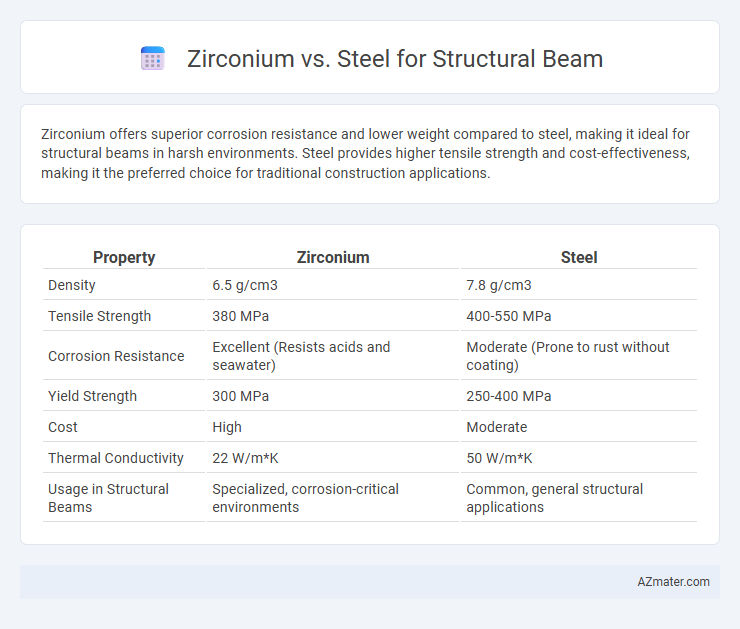Zirconium offers superior corrosion resistance and lower weight compared to steel, making it ideal for structural beams in harsh environments. Steel provides higher tensile strength and cost-effectiveness, making it the preferred choice for traditional construction applications.
Table of Comparison
| Property | Zirconium | Steel |
|---|---|---|
| Density | 6.5 g/cm3 | 7.8 g/cm3 |
| Tensile Strength | 380 MPa | 400-550 MPa |
| Corrosion Resistance | Excellent (Resists acids and seawater) | Moderate (Prone to rust without coating) |
| Yield Strength | 300 MPa | 250-400 MPa |
| Cost | High | Moderate |
| Thermal Conductivity | 22 W/m*K | 50 W/m*K |
| Usage in Structural Beams | Specialized, corrosion-critical environments | Common, general structural applications |
Introduction to Zirconium and Steel in Structural Engineering
Zirconium offers exceptional corrosion resistance and high strength-to-weight ratio, making it a niche material in structural engineering where durability in harsh environments is critical. Steel remains the dominant choice for structural beams due to its superior tensile strength, cost-effectiveness, and well-established fabrication methods. Engineers select steel for most applications requiring load-bearing capacity and structural stability, while zirconium is reserved for specialized projects demanding resistance to chemical degradation.
Material Properties: Zirconium vs Steel
Zirconium exhibits superior corrosion resistance and a higher melting point compared to steel, making it ideal for environments with extreme temperatures and aggressive chemicals. Steel, particularly carbon and alloy variants, offers greater tensile strength and cost-effectiveness, providing robust load-bearing capacity for structural beams. The lower density of zirconium results in lighter components, but steel's well-established mechanical properties and widespread availability make it the preferred choice for most structural applications.
Strength and Load-Bearing Capacity Comparison
Zirconium exhibits high corrosion resistance but generally has lower tensile strength and load-bearing capacity compared to structural steel, which offers superior strength and durability for heavy load applications. Structural steel grades, such as ASTM A992, deliver yield strengths around 50 ksi (345 MPa) and excellent fatigue resistance critical for beams under dynamic loads. Zirconium alloys, while resistant to harsh environments, typically feature tensile strengths below 100 ksi (690 MPa) but lack the cost efficiency and stiffness steel provides in large-scale structural frameworks.
Corrosion Resistance in Structural Applications
Zirconium offers exceptional corrosion resistance in structural beam applications, outperforming steel especially in aggressive environments such as marine or chemical processing industries. Unlike steel, which often requires protective coatings to prevent rust and degradation, zirconium naturally forms a stable oxide layer that provides long-term durability without maintenance. This intrinsic corrosion resistance makes zirconium beams ideal for structures exposed to harsh chemicals, saltwater, and extreme temperatures, enhancing lifespan and reducing lifecycle costs.
Weight and Density Differences
Zirconium has a significantly lower density of approximately 6.52 g/cm3 compared to steel's density, which ranges from 7.75 to 8.05 g/cm3 depending on the alloy. This density difference makes zirconium beams lighter, offering potential advantages in applications where weight reduction is crucial. Despite being lighter, zirconium also exhibits excellent corrosion resistance and strength, but steel remains more cost-effective and widely used for structural beams due to its higher stiffness and availability.
Cost Analysis: Zirconium vs Steel Beams
Zirconium beams exhibit higher material and fabrication costs compared to conventional steel beams due to zirconium's rarity and complex processing requirements. Steel beams remain cost-effective for most structural applications, offering lower initial expenses and widely available manufacturing infrastructure. Long-term maintenance and corrosion resistance advantages of zirconium may offset initial costs in specialized environments but do not generally justify widespread use over steel.
Fabrication and Ease of Installation
Zirconium offers superior corrosion resistance and lower weight compared to steel, facilitating easier handling and installation of structural beams in challenging environments such as marine or chemical industries. Steel beams, while heavier and more labor-intensive to fabricate due to welding and cutting requirements, provide widespread availability and cost-effective fabrication options with well-established structural standards. The fabrication of zirconium beams typically demands specialized equipment and expertise, which can increase initial installation complexity despite long-term benefits.
Longevity and Maintenance Requirements
Zirconium beams exhibit superior corrosion resistance compared to steel, significantly enhancing longevity in harsh environments such as marine or chemical industries. Steel, while cost-effective and strong, requires frequent maintenance including rust prevention and coating applications to avoid structural degradation. The inherent durability of zirconium reduces long-term maintenance needs, making it a more sustainable choice for critical structural applications.
Environmental Impact and Sustainability
Zirconium offers superior corrosion resistance and longer lifespan compared to steel, reducing the need for frequent replacements and minimizing resource consumption. Steel production has a high carbon footprint due to intensive mining and energy use, whereas zirconium manufacturing involves specialized processes with lower greenhouse gas emissions when sourced responsibly. Sustainable structural engineering benefits from zirconium's durability and recyclability, contributing to reduced environmental impact over the building's lifecycle.
Choosing the Right Material for Structural Beams
Zirconium offers exceptional corrosion resistance and high-temperature stability, making it ideal for specialized structural beams in harsh environments, although its cost and lower strength-to-weight ratio compared to steel limit widespread use. Steel remains the preferred choice for most structural beams due to its superior tensile strength, cost-effectiveness, and versatility in construction applications. Selecting the right material depends on factors such as environmental conditions, load requirements, budget constraints, and long-term durability needs.

Infographic: Zirconium vs Steel for Structural beam
 azmater.com
azmater.com